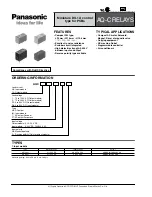
TYP ES CA-16 AND CA-26 R ELAYS
-----
(f.t.)
1•1CATIN
COIU.CTOI
IIITCII
lOP IBT
itiiiiD
EI.88fT
---
(f,Y.)
lOT£:
IITNlELATI'IE IIISTAI•
TAIECMIS POWITIU
AS
111M.
Tit£ AMPU£
TURIS
U
TME PAllED
IEITIAIIIIII COILS ADO
TO
I'IODUC£
UIIMUII
TOIQUE·
Llfl ... IL&.
(f,,.)
VIIH-B811f
(F.¥4)
187A434
Fig.
5.
Internal Schematic of the Type CA- 1 6 Bus Relay
with a Sens itive Fault Detector
switch. When the switch closes, the moving contacts
bridge two stationary contacts, completing the trip
*circuit. Also during this operation, (for the liT only)
two fingers on the armature deflect a spring located
on the front of the switch which allows the operation
indicator target to drop. The target is reset from the
outside of the case by a push rod located at the
bottom of the cover .
A core screw accessible from the top of the switch
provides the adjustable pick-up range.
OPERAT ION
The types CA-16 and CA- 26 relays are induction
disc relays with four electromagnets mounted on two
discs that are fastened on a common shaft. One of
the elect romagnets is the operating element while
the other three are restraint elements. The restraint
elements are energized from the secondaries of cur
rent transformers connected to the bus, and the
operating circuit is energized in accordance with the
current flowing in the differential connection of the
current transformers.
A current of 5 amperes in at terminal
18
and out of
terminal
10
will produce a definite amount of re
straining torque (see Fig. 3.) Similarly, a current of
5 amperes flowing in at terminal 16 and out of ter
minal 17 will produce an equal amount of torque. If
both of these currents flow at the same time with the
4
"f.
240
8
�
160
j
ii
CA-16
!:
120
�
40
20
60
80
100
120
140
160
OPERATING CURRENT IN AMPERES
Curve 537956
Fig. 6. Typ ical Time Curves of the CA- 1 6 and CA-26 dif·
ferential Relays
polarity as indicated above, their effect will be addi
tive and they will produce the same torque as though
10 amperes were flowing in terminal 16 and out of ter
minal
17.
Conversely, if equal currents flow in these
two coils, but in opposite directions, their ampere
turns will cancel and no torque will be produced. The
same relationship applies for the paired coils of the
other two restraining units of the relay. The restraint
effect will always be additive if currents flow in the
coils which belong to different restraint elements.
C HARAC T E R ! S T E R I C S
C A-16 Bus Relay
This relay has variable percentage characteristics
which means that the operating coil current required
to close the relay contacts, expressed in per cent of
the total restraint current, varies with the magnitude
of the restraint current. The relay sensitivity is high,
corresponding to a low percentage ratio, at light cur
rents, and its sensitivity is low, corresponding to
high percentage unbalance, at high currents. The re
lay is made sensitive at low currents in order to de
teet light internal faults on the bus being protected .
At the same time, however, its reduced sensitivity at
the higher currents allows the various current trans
formers involved to depart from their true ratio to a
large extent without causing false tripping of the re
lay for external faults.
The variable percentage characteristics are par
ticularly advantageous when severe saturation of cur
rent transformers is caused by the d-e c omponent of
asymmetrical
short circuits . In the case of buses
located close to generating stations where the d-e
components decay slowly, the breakdown in ratio of
the current transformers will be much greater than
www
. ElectricalPartManuals
. com












































